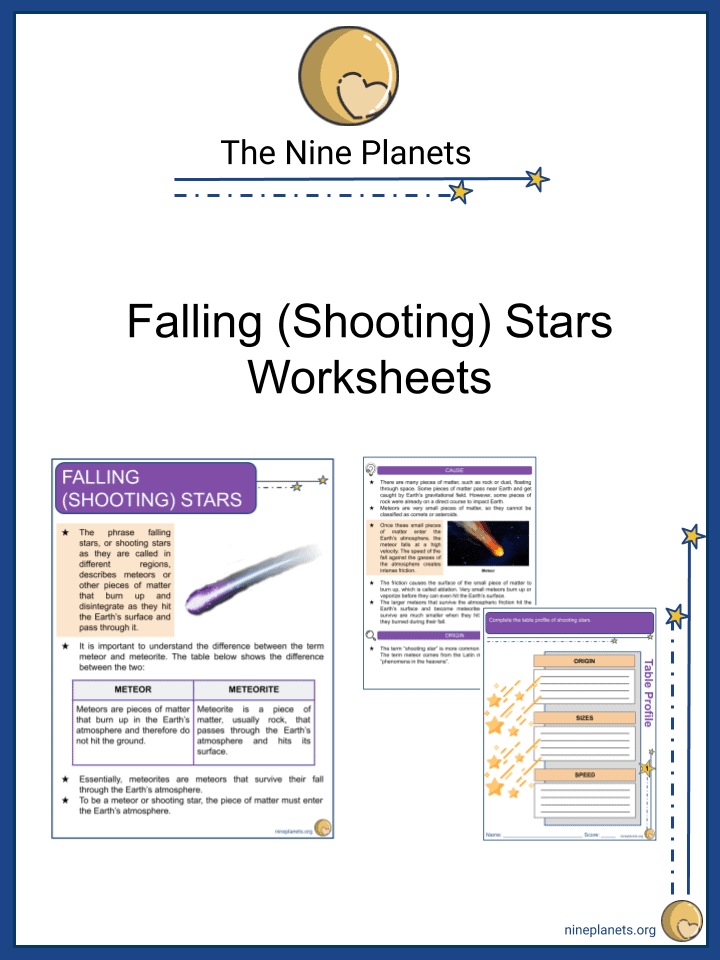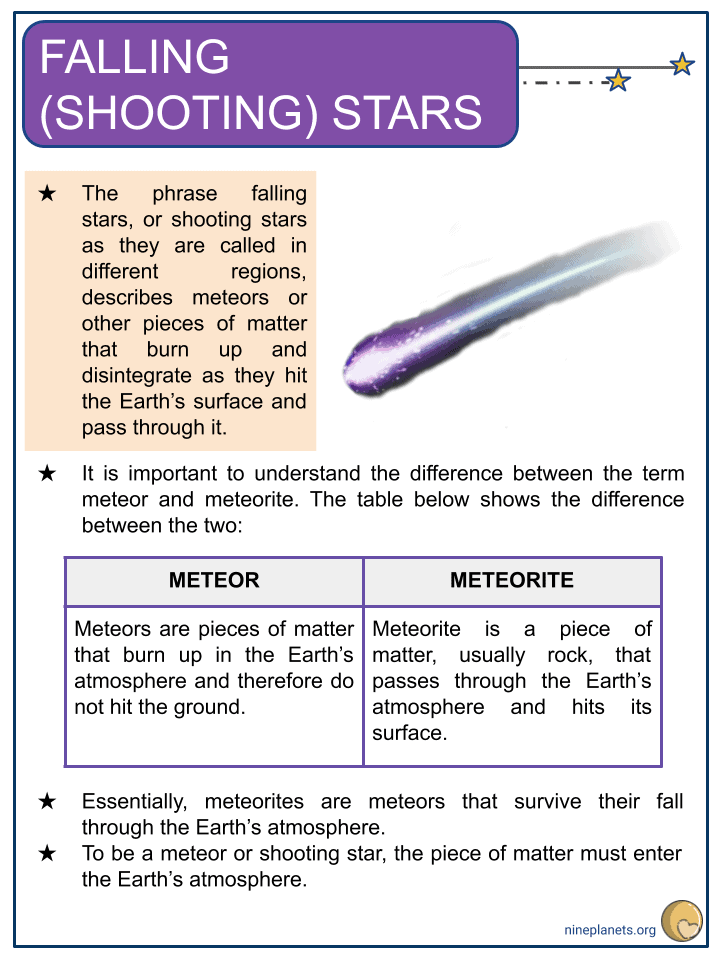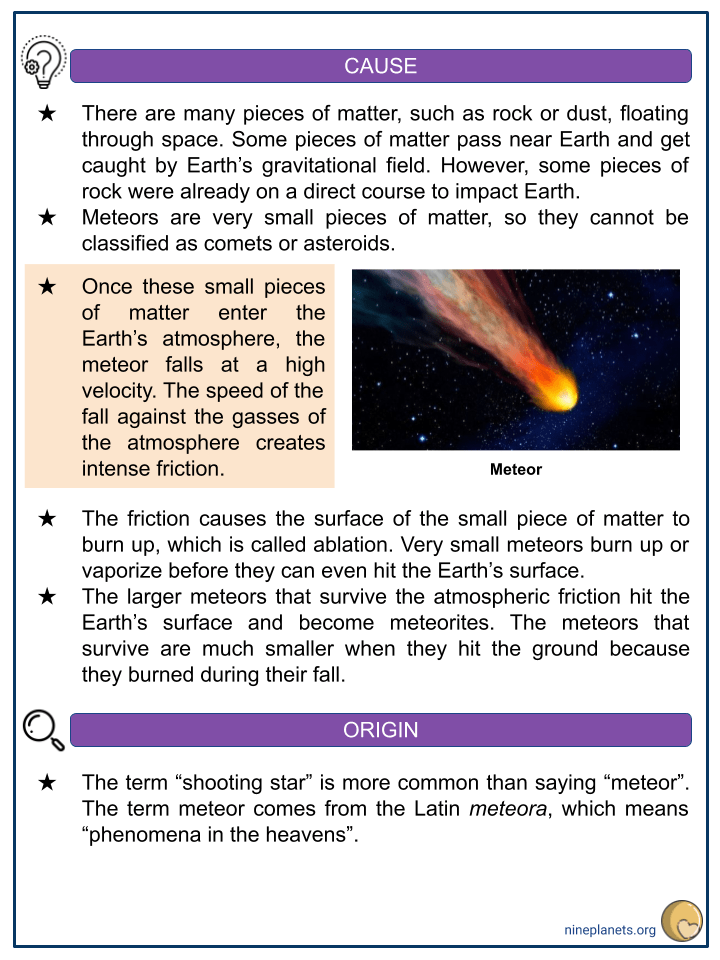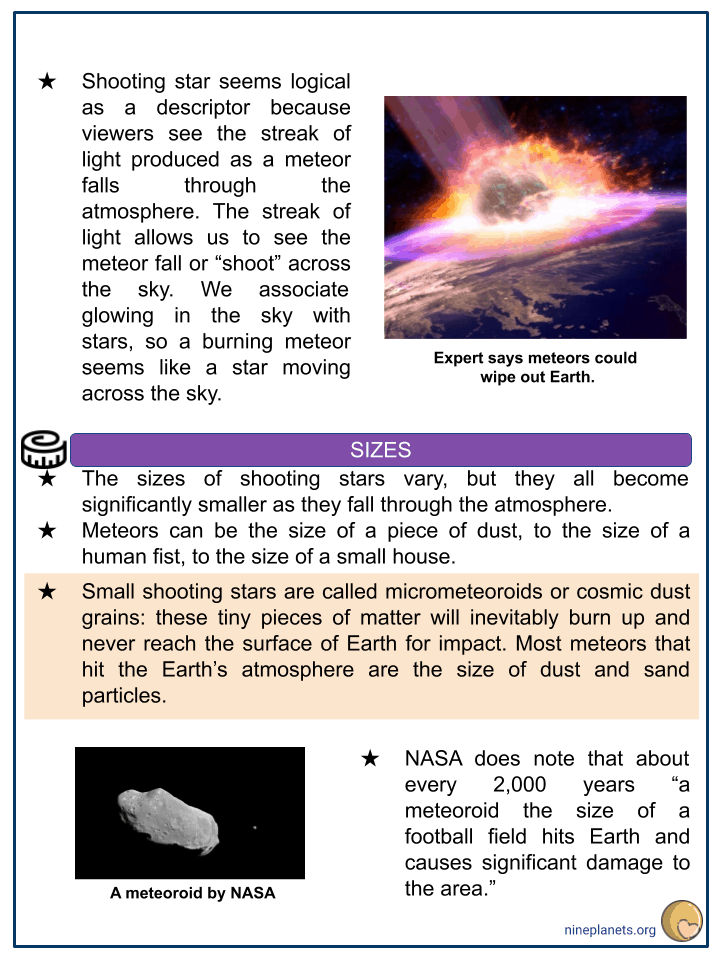Download Falling (Shooting) Stars Worksheets
Click the button below to get instant access to these premium worksheets for use in the classroom or at a home.

This worksheet can be edited by Premium members using the free Google Slides online software. Click the Edit button above to get started.
Download free sample
Not ready to purchase a subscription yet? Click here to download a FREE sample of this worksheet pack.
Resource Examples
Click any of the example images below to view a larger version.




Key Facts & Information
- The phrase falling stars, or shooting stars as they are called in different regions, describes meteors or other pieces of matter that burn up and disintegrate as they hit the Earth’s surface and pass through it.
- It is important to understand the difference between the term meteor and meteorite. The table below shows the difference between the two:
- METEOR: Meteors are pieces of matter that burn up in the Earth’s atmosphere and therefore do not hit the ground.
- METEORITE: Meteorite is a piece of matter, usually rock, that passes through the Earth’s atmosphere and hits its surface.
- Essentially, meteorites are meteors that survive their fall through the Earth’s atmosphere.
- To be a meteor or shooting star, the piece of matter must enter the Earth’s atmosphere.
Cause
- There are many pieces of matter, such as rock or dust, floating through space. Some pieces of matter pass near Earth and get caught by Earth’s gravitational field. However, some pieces of rock were already on a direct course to impact Earth.
- Meteors are very small pieces of matter, so they cannot be classified as comets or asteroids.
- Once these small pieces of matter enter the Earth’s atmosphere, the meteor falls at a high velocity. The speed of the fall against the gasses of the atmosphere creates intense friction.
- The friction causes the surface of the small piece of matter to burn up, which is called ablation. Very small meteors burn up or vaporize before they can even hit the Earth’s surface.
- The larger meteors that survive the atmospheric friction hit the Earth’s surface and become meteorites. The meteors that survive are much smaller when they hit the ground because they burned during their fall.
Origin
- The term “shooting star” is more common than saying “meteor”. The term meteor comes from the Latin meteora, which means “phenomena in the heavens”.
- Shooting star seems logical as a descriptor because viewers see the streak of light produced as a meteor falls through the atmosphere. The streak of light allows us to see the meteor fall or “shoot” across the sky. We associate glowing in the sky with stars, so a burning meteor seems like a star moving across the sky.
Sizes
- The sizes of shooting stars vary, but they all become significantly smaller as they fall through the atmosphere.
- Meteors can be the size of a piece of dust, to the size of a human fist, to the size of a small house.
- Small shooting stars are called micrometeoroids or cosmic dust grains: these tiny pieces of matter will inevitably burn up and never reach the surface of Earth for impact. Most meteors that hit the Earth’s atmosphere are the size of dust and sand particles.
- NASA does note that about every 2,000 years “a meteoroid the size of a football field hits Earth and causes significant damage to the area.”
Speed
- The speed of a shooting star depends on how and when the meteor enters the Earth’s atmosphere. On average, the speed of a meteor ranges from 11/km/sec to 72 km/sec, which is 25,000 mph to 160,000 mph.
- Since the Earth is always spinning, some meteors may need to catch up to the spin to reach the atmosphere. However, some meteors may meet the spin and hit the atmosphere directly, or head-on. The meteors that hit head-on tend to move faster than the ones that need to catch up to the Earth’s spin.
Best Time To See
- Shooting stars are occurring all the time, even during the day. The best time to see one is at night since you can readily see the trail it leaves behind. It is also best to find a location away from cities and light pollution. The darker the sky, the better chance you have of seeing a shooting star.
- Also, you will have an increased chance of seeing a shooting star during a meteor shower. A meteor shower is a bunch of pieces of a comet that have been left behind or broken off the comet.
Interesting Facts
- Over 25 million meteors hit the Earth’s atmosphere every day.
- Chondrites, which are stone meteorites, are the most common type of meteorite.
- Meteor showers are also called swarms.
- Meteor showers can last between a few days to a few weeks.
- Only about 33% of meteorites were witnessed during their fall: most are found without the fall being seen.
- The Barringer Crater in Winslow, Arizona, was created by a meteor around 30–50 meters in diameter.